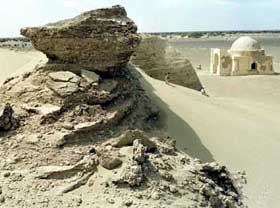
Heicheng, the largest and best-preserved ancient city site along the Silk Road that linked China with Central and Western Asia, is being devoured by flowing sand.
Left photo dated May 28, 2004 shows a section of the eroded wall and a mosque in Heicheng.
About 25 km to the southeast of Dalai Hubu Township in north China's Inner Mongolia, the archeological site is well known for its ten-meter-high city walls and a pagoda dating back to the Xixia Dynasty (1038-1227).
Given that the dynasty established by Dangxiang, a branch of the Qiang nationality, left no official written documents, Heicheng has been viewed as priceless by archeologists worldwide.
But as the ecology of nearby Juyan Oasis keeps deteriorating over the past three decades, many previously solid sand dunes started to move toward the archeological site. Although some biological projects have been done in an attempt to curb the sprawling sand, archeologist Liu Honggui believe the danger has not been defused yet.
As a result, many parts of the city walls have been gradually reduced to debris and virtually made way for the sand pushing ahead.
Photo dated May 28, 2004 shows pagodas eroded by sandstorms in Heicheng.
Since it was discovered by a Russian explorer surnamed Potanin in 1886, Heicheng has become a mecca for worldwide archeologists including P. K. Kozlov, Aurel Stein and Sven Hedin.
After its founding in 1949, the People's Republic of China initiated two large-scale archeological research projects in 1983 and 1984 respectively. From then, archeologists excavated hundreds of tombs owned by Muslims of the Yuan Dynasty (1271-1368) crucial to the study of Islamic culture's spread in China.
(Xinhua News Agency August 2, 2004)
|

